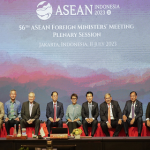If Southeast Asia is the heart of the Indo-Pacific, the 56th Foreign Ministers Meeting (FMM) of the Association of Southeast Asian Nations (ASEAN), the post-ministerial conferences and other related regional meetings, held in Jakarta, Indonesia in mid-July, 2023, are the best barometer to check on the region’s latest dynamics. An elaborate institutional architecture created by ASEAN has become an inclusive platform that draws nations from near and far, as also all major players (the United States, China, India, Japan and Russia) engaged in shaping the strategic contestation in a vast region stretching from east Africa to the South Pacific.
An in-depth study of various outcome documents, particularly the joint communiqué of the FMM, is indicative of ASEAN’s brave attempts to navigate through transformative changes in the present decade: the impact of the COVID-19 pandemic, economic slowdown, the Ukraine war, climate change, and, above all, the Cold War-type confrontation between the United States and China. As the current chair, Indonesia has portrayed ASEAN as “the Epicentrum of Growth”. It is a well-chiselled vision with three inter-related dimensions: creating a political community that ensures regional peace and a just, democratic and harmonious environment; an economic community focused on achieving a well-integrated and connected regional economy within the global economic system; and a socio-cultural community to enhance the quality of life of ASEAN’s citizens as well as sustainable development of the region.
Addressing fellow Foreign Ministers on July 11, Retno Marsudi, the Minister for Foreign Affairs of Indonesia and chair, argued that ASEAN’s ability to manage regional and global dynamics depended on two critical ingredients that promote its unity and centrality. First, it should maintain its credibility by adhering to the ASEAN Charter, and second, it should stay in the driver’s seat while navigating regional dynamics. Laudable as these goals are, they are becoming less achievable. ASEAN’s internal differences on issues such as Myanmar keep surfacing in public. Its desire to lead the region and shape its agenda stands jeopardised by the strained relationship between the U.S. and China.
China enjoys close political and economic relations with the ASEAN states, and at least three of them, i.e., Laos, Cambodia and Myanmar, are its virtual dependencies. While the Philippines has become more assertive of late in its claims in the South China Sea, the central players, Indonesia, Malaysia, Singapore and Thailand, are all favourably disposed towards Beijing. This explains why none of them raises its voice against China’s delaying tactics in negotiating an enforceable code of conduct concerning the South China Sea. For many years, ASEAN and China have called for “an early conclusion of an effective and substantive” code of conduct; they did it this year too, but are content to leave the matter there. No indication of a timeline is given. It is hard to find a similar example of diplomatic doublespeak.
ASEAN also watches helplessly the acrimonious debate between the U.S. and Chinese governments, despite Washington’s recent attempts to revive constructive discussions through high-level visits. The Chinese argument is that the U.S. is solely responsible for poor relations because it steadily refuses to accept and accommodate itself to China’s ‘peaceful rise.’ The U.S., on the other hand, is no longer willing to turn a blind eye to Chinese aggressiveness and coercion in the Indo-Pacific and beyond. The latest manifestation of this thinking appeared in North Atlantic Treaty Organization’s Vilinius summit communiqué which stated, “The People’s Republic of China’s stated ambitions and coercive policies challenge our interests, security and values.”
Anxious over “the intensifying geopolitical tensions in the region,” ASEAN prefers to promote the ASEAN Outlook on the Indo-Pacific (AOIP). Its four identified areas ( maritime cooperation, connectivity, UN Sustainable Development Goals 2030 and economic cooperation) make much sense to the region. Predictably though, despite ASEAN partners reaffirming support for the AOIP, its actual implementation remains a worry.
ASEAN reiterated its centrality, but it appears vulnerable when the grouping is unable to forge unity on a most sensitive issue, the Myanmar situation, which has led ASEAN to bar a member-state (Myanmar) from all its political-level discussions. In the run-up to the FMM, Thailand, defying ASEAN’s official policy, ran its own dialogue with the military government which permitted the Thai Deputy Prime Minister and Foreign Minister to have a meeting with Daw Aung San Suu Kyi, much to the discomfiture of Indonesia, the ASEAN chair. The split in ranks was acknowledged in the joint communiqué. This disunity could not be concealed by a routine reaffirmation of the Five-Point Consensus (5PC) forged in April 2021. Without unity, ASEAN centrality loses much of its credibility.
The significance of the ASEAN meetings to India is apparent when viewed in the context of External Affairs Minister S. Jaishankar preferring to represent India at the post-ministerial conference and other regional dialogues, instead of accompanying the Prime Minister on his visits to France and the United Arab Emirates earlier in July. He pointedly referred to the importance of a “strong and unified” ASEAN in the emerging dynamic of the Indo-Pacific, and highlighted the convergence between the AOIP and India’s Indo-Pacific Oceans Initiative. To build on the comprehensive strategic partnership between India and ASEAN, he suggested that the two sides work in “newer areas such as cyber, financial and maritime security domains.
Though it appeared that ASEAN did not make much progress, and no new ground was broken, its persistence with dialogue, internally and externally, prevents geopolitical temperatures from rising. The next ASEAN summit will be held in Jakarta in September 2023. Hopefully, this may bring greater clarity on the way to tackle challenges confronting the region.
Ambassador Rajiv Bhatia is Distinguished Fellow, Foreign Policy Studies, Gateway House and a former ambassador.
This article was first published in The Hindu.


